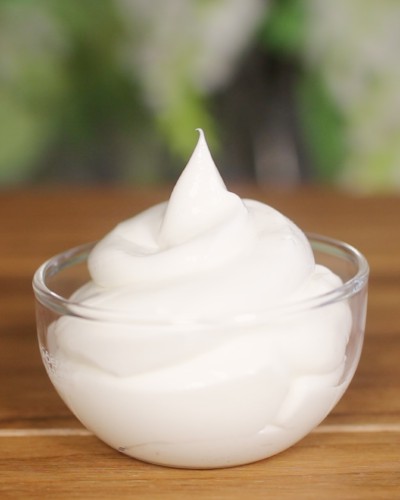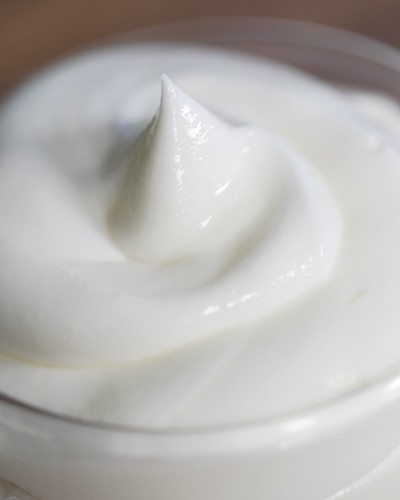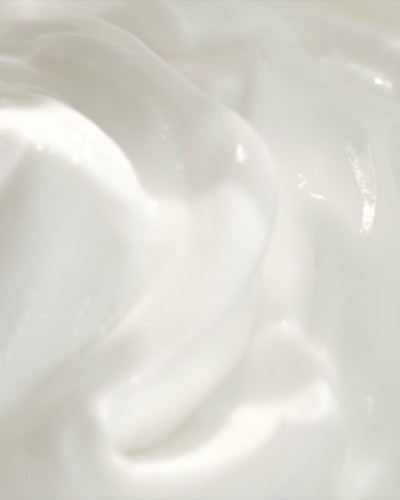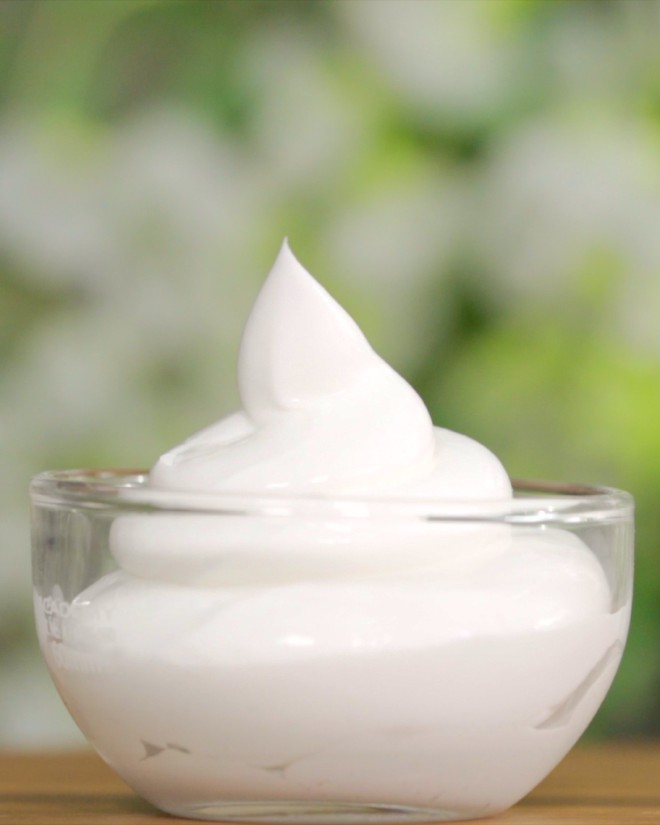Part of the Milk, Yogurt & Cream Lotion series.
Recipe
Water Phase
- 142g Distilled Water
- 4g Glycerine
Oil Phase
- 30g Fractionated Coconut Oil
- 10g Mango Butter
- 10g Emulsifying Wax NF
- 4g Cetearyl Alcohol
Cool Down
- 2g Optiphen (Preservative)
- 2g Vitamin E Oil (Antioxidant)
- 2g Essential Oil (Optional Fragrance)
Method
- Measure out your water phase ingredients: Distilled Water and Glycerine, as well as your oil phase ingredients: Fractionated Coconut Oil, Mango Butter, Emulsifying Wax NF and Cetearyl Alcohol.
- Gently melt both phases in separate heatproof containers over low heat, using either a bain-marie or double boiler method, stirring occasionally.
- When both phases are completely liquid, pour the molten oil phase into the water phase. Immediately blend with an immersion blender until the mixture turns opaque and homogenous. As the emulsion cools it will continue to thicken until it starts to resemble a cream.
- Once the cream has cooled to room temperature, and has a thick cream consistency, measure out your cool down ingredients: Optiphen, Vitamin E Oil and any optional Essential Oils for fragrance.
- Mix thoroughly to ensure the cool down ingredients are fully incorporated into your body cream.
- Transfer your cream to a tub-style container and store away from direct sunlight.
This recipe makes 200g of homemade body cream and will last approximately 3 months. See the interactive formula to customise this recipe.
How to make body cream

Creams vs lotions
At this point the line between skincare products has become so blurred it’s almost unnecessary to sweat the small stuff like whether you’re making a cream or a lotion. Essentially they’re the same product - both lotions and creams are emulsified moisturisers that consist largely of water.
Traditionally creams were thicker, and more intensive moisturisers that were usually contained in pots and tub-style containers. Lotions, however, were considered lighter, runnier moisturisers that worked best in pump or squeeze bottles. Due to this clear distinction, it was safe to assume creams were more moisturising due to their thicker texture.

But an interesting fact that you learn when you’re making your own cosmetics is that a lotion’s consistency is largely determined by the emulsifying wax rather than the oil or butter content. It’s more than possible to make a cream that simply appears thicker but has the same amount of moisturising elements as a looser lotion.
So for this recipe, I’ve kept the oil content to around 20% which is fairly light for a cream, but makes for a much easier emulsification process!
Why you should make your own cream
Making your first homemade cream is one of the most rewarding things you can do! It’s like unlocking a secret life hack that only you and a small amount of people even know about. But there are signifcant advantages to making your own cream, a few of which I’ve listed below.
Benefits of homemade cream
- You know EXACTLY what goes into it
- Great for sensitive or specialist skin conditions
- Easier to avoid irritants and skin-sensitising ingredients
- Makes the most of natural ingredients: butters, oils & botanical extracts
- Endless customisation, got a favourite butter or oil? Well now you can include it in all your creams

Substitutions
This homemade body cream recipe is easy to customise and alter depending on what you have available. Please see below for a list of common substitutions:
- Glycerine: can be replaced with an equal amount of honey
- Fractionated coconut oil: any light to medium-bodied oil will work (e.g. almond, sunflower, jojoba, grapeseed etc.)
- Mango butter: low melting point, soft butters work best but you can also use any vegetable butter (Shea Butter, Cocoa Butter, Cupuaçu Butter etc.)
- Emulsifying Wax NF: can be substituted with another complete or self-emulsifying wax. Example of emulsifying waxes with a similar texture are Olivem 1000, polarwax, and emulsifying wax BP
- Cetearyl Alcohol: any fatty alcohol will work (e.g. cetyl alcohol, stearyl alcohol etc.)
- Optiphen: can only be substituted with another broad-spectrum preservative (e.g. preservative eco, geogard, optiphen plus). Use at the recommended usage rate.
